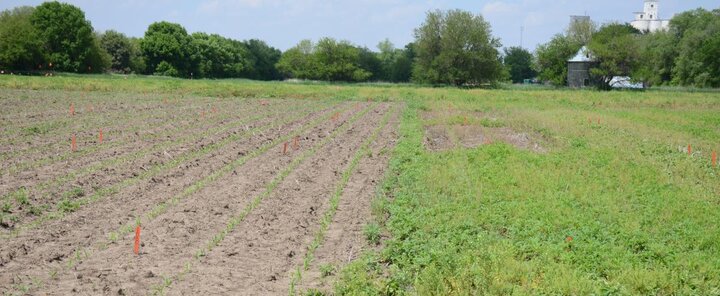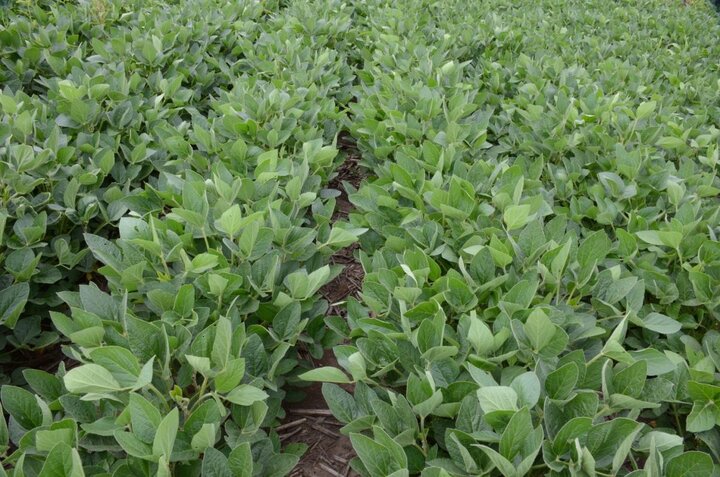
Figure 1. UNL field trial showing control of giant ragweed in corn field after preplant tillage (left) and without preplant tillage (right).
Tillage refers to the mechanical manipulation of soil for a number of reasons, including to prepare the seedbed for crop planting, residue management, or weed removal. Tillage suppresses or removes weeds by severing shoots from roots, uprooting or covering unwanted vegetation, stirring weed seeds both vertically and horizontally, and modifying the soil environment to promote or inhibit seed germination and establishment.

Despite certain limitations, tillage has been an important method of weed control, specifically before the era of no-till or glyphosate-tolerant crops. However, selectivity, flexible application timing, and low costs of herbicides such as glyphosate in glyphosate-tolerant crops promoted adoption of chemical weed control. These changes also contributed to a significant decline in use of tillage as more growers adopted minimum or no-till cropping systems.
In time an over-reliance on glyphosate resulted in the evolution of glyphosate-resistant weeds. As of 2015, six weeds had been confirmed resistant to glyphosate in Nebraska: common ragweed, common waterhemp, giant ragweed, marestail, kochia, and Palmer amaranth. With no new herbicide sites-of-action being discovered, it has become necessary to adopt diversified weed management approaches to manage herbicide-resistant weeds and preserve the use of those herbicides already in the marketplace.
Tillage can be an important tool in diversified weed management when used judiciously and combined with other weed control tools such as crop rotation and herbicides. It’s important to identify when integrating tillage to achieve weed management will be feasible and provide better efficacy and more benefits compared to other options. For example, weeds such as giant ragweed (most of which emerges before corn/soybean planting in Nebraska) will be easy to control with preplant tillage.
To answer grower questions, research studies were conducted to evaluate integrated management of glyphosate-resistant giant ragweed with preplant tillage followed by pre-emergence and/or post-emergence herbicides in soybean and corn. The studies were in growers’ fields in Clay Center and David City in 2013 and 2014 (Figure 1). Preplant tillage was accomplished with a three-point tractor-mounted tandem disk in the first week of May both years.


Preplant tillage resulted in more than 80% control of early emerged giant ragweed and was comparable to 2, 4-D applied preplant (Figure 2). Preplant tillage allowed planting of corn and soybean in fields with reduced or no giant ragweed pressure (Figures 3 and 4). Planting corn/soybean under weed-free or reduced giant ragweed pressure resulted in
- no or reduced competition with emerging crop seedlings (Figure 3), and
- improved performance of pre-emergence and post-emergence herbicides in corn and soybean.

Using preplant tillage followed by pre-emergence and/or post-emergence herbicides provided more than 97% control of giant ragweed throughout the crop season. In addition, the contrasts between treatments showed higher yield for both corn and soybean with preplant tillage followed by pre-emergence and/or post-emergence herbicide programs compared to pre-emergence followed by post-emergence herbicide program without preplant tillage.
More details about the integrated management programs for giant ragweed control in soybean can be found in in a paper recently published in Weed Technology, Integrated Management of Glyphosate-Resistant Giant Ragweed (Ambrosia trifida) with Tillage and Herbicides in Soybean.
In conclusion, preplant tillage is an important weed control option to help you start planting season under weed-free conditions. However, a strategy using pre-emergence and/or post-emergence herbicides with different sites-of-action is indispensable to achieving effective season-long weed control.
